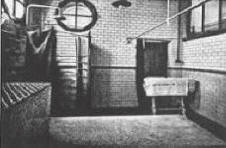7. Publicly funded Turkish baths

The building of publicly funded Turkish baths began warily. Some local government officers argued that such funding was not permitted under the provisions of the Baths and Wash-houses Acts, while political opponents pointed out that in any case the acts were permissive rather than mandatory.
In Southampton the Local Government Board,
would not allow the Council to borrow money for the erection of Turkish baths, as they said they had no power to do so, but the Town Council found a way out of the difficulty, and they applied for a loan for £1,000 for vapour baths; these were Turkish baths under another name, and, as is well known, the work was subsequently carried out.119
Southampton was not the only authority to argue with more common sense than accuracy, that the Turkish bath was only a type of vapour bath and, as such, was specifically allowed under the Acts.
Among the first local authorities to dip their toes in the hot air were Bradford Corporation whose Sanitary, Baths and Cemetery Committee built Turkish baths in Thornton Road in 1865,120 as did the Baths Committee of Ashton-under-Lyne Corporation within their new Public Baths in Henry Square five years later.121
Both committees seemed pleased with the results. In 1867, for example, the Bradford establishment provided 1,812 Turkish baths tickets at 6d each, and 3,350 at 3d each—a total of £174. 7. 0. for the year.122 While, in 1879, Ashton provided 4,914 tickets.123
In the early 1870s, Richard Metcalfe served as a member of Paddington Vestry. He advocated the adoption of the Baths and Wash-houses Acts in Paddington, and urged that Turkish baths should have their rightful place in such publicly funded provision. Single-handed, he wrote to every Turkish bath proprietor known to him (in addition to medical officers of health, clergymen, and national politicians) asking for their support. The replies he received give us a sharp, and unusual, insight into the typical middle-class view, frequently patronising, of the needs of members of the Victorian working-class.124
In 1874, when the Paddington Vestry decided not to include a Turkish bath in their new bathing and washing facilities, Metcalfe resigned. The vestry did, however, agree to reserve space for one in case their decision were to be reversed at a later date. Paddington’s Turkish baths, though still open today, were not built until 1929.125
Tracing the history of local authority establishments is greatly helped by the existence of committee minutes which frequently provide useful information about running costs, wages, and usage statistics.


